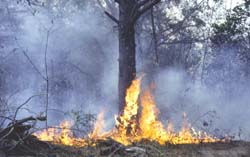

Fire suppression caused a dramatic change in the composition of Illinois forests. Prior to European settlement, fires occurred more frequently, eliminating the fire-intolerant species such as sugar maple from mature oak-hickory forests.
When fire was suppressed, sugar maple and other fire-intolerant trees were no longer removed from the forests on a regular basis. They prevented the regeneration of the oaks by producing excessive shade. Sugar maples produce a great quantity of seeds, which are able to survive in their own dense shade as saplings until a gap in the canopy appears and they can grow. Oaks seedlings cannot tolerate shady conditions.
Today, in many of the major forest types, the dominant trees in the canopy are older oaks, whereas the younger trees in the sub-canopy are predominantly sugar maples. Unless fire is used as one of the management tools for these forests, they will eventually be dominated by sugar maple with a suite of other fire-intolerant species.
Soil erosion is another problem in degraded forests where minimal light reaches the ground layer. Light levels decline to the detriment of many native herbaceous layer plants, and the ground layer becomes sparse and species poor and the soils unstable, eventually washing away.
|
|
Copyright © 2000 Illinois State Museum